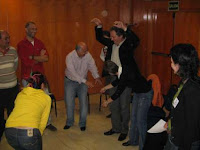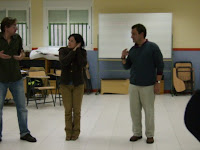
In the Ancient market of the Archeological Area of Philippi.
LET'S LEARN BY PLAYING is an European Project belonging to LIFELONG LEARNING PROGRAMME GRUNDTVIG.





The idea is to conceive an activity by making several disciplines intercede : (in that case the subjects which intervened were : biology-ecology: history-geography; artistic plans.)
This multidisciplinary approach gets organized around a topic : here the chosen topic : "life and habits of a small village of fishers from Bretagne". The interest of this approach is to enable pupils to have a broader vision of discreet topic.All the aspects, all the complexity of a situation, are taken into account.
At first, a reading of the landscape is planned, first sensory, then rational.( An activity organised by the teacher of biology- ecology).
In third time, an artistic production is attended, using all this acquired knowledge (artistic plan).
This production is suggested to assess the understanding of what was made in the first two periods (the reading of the landscape, the knowledge of the historical aspect) and the pupils connected the landscape and the fishers'life of the village.
The aim is also to check if the pupils are able to use that knowledge into another language(realization of a comic strip or simply one part, here one asked for it to accomplish the first picture of a comic strip on this fishers'village).
But it is possible also to ask the pupils to realize a brochure making the promotion of the local area or to make an artistic photograph reflecting the atmosphere of the place or a to make a lifelike portrait or a play.....
example : "Territory of Ménéham on April 22nd 2009"
When we work on the reading of a landscape, we first have a sensitive oncoming : (we show that all of us have a different view).
Then we have a rational oncoming by watching the different components. These observations led to questions which we tried to answer.
HOW TO PRACTICE
I) I notice what guides my perception : sensitive approach
Game of the blindfolded eyes
2 persons : one has his eyes blindfolded and while the other describes him the landscape he can see. then the blindfold is taken away and the pupil can realize how distant was the picture he had from the reality.
It highlights the different views on the same territory and the relativity of descriptions notably through the adjectives mentioned (big, ugly, frightening, splendid) or the most favourite elements (the flora, habitats....) This game shows us the subjective aspect of a landscape.
Another sensitive or sensory approach : I use my 5 senses to get to know the landscape:
The sight : what is the predominant colour in my opinion?
(In ménéham, answers were very various and very amazing really showing some subjectivity : the guides thought that everybody would have sad "blue" in comparaison to the ubiquitous sea) and the colours mentionned were "black"(presence of huge granite blocks covered with very datk seaweeds), "yellow"(presence of sand, "green"(presence of the grass on the dunes where the reading of landscape was made.
Hear : what do I hear ?
In ménéham, they heard the wind(always very present on this coast) and the marine birds.
Smell : What can I smell ?
In Ménéham, they smelt the sea, "of some iodine"seaweeds.
Touch : what do I feel on the skin?
In Ménéham , they smelt the cool(cold) wind
II) I spot and I locate
For that I use a map.
I spot the place of observation(name of the said place, the village...)
I orientate the map, and I turn using the four cardinal points and using as a point of reference the village or the close city
III) I represent and I classify : rational approach
a) The natural data
Relief and under soil
I put a name on the main elements of the relief (mountain, valley, hil....)
Here we can see what we call"granitic chaos". They took place 100 000 years ago......; Then the sea and the wind have eroded these stones and have transformed them in sand. The sand has been carried by the wind and has formed the dunes.
Waters
I established a list of different noticed forms(sea, lake, rivers, ponds, marsh, reservoir..)
The sea is here the most important thing in this landscape. The human activities depend of it.
Natural vegetation
I point out the place and the importance in the landscape of the different vegetations.
Here the ground is especially sand. This ground is not good for the agriculture and farming : only sand and more the sand do not keep water. The only plants we can see are adapted to this poor environment and are not useful to feed humans people.But these plants grow especially on sand and for some of them are rare and now protected.
So people here were very poor and have to fish to feed themselves. That's we can see here : some small boats and a hold (a way to accede to the beach)
Those poor people also fished seaweeds: they sold them to chemical engineering(industries)because they extraded iodine and soda from the seaweeds by burning them.They also used seaweeds to fertilize their fields.
Fauna
I search presence or signs of activity of wild animals(and of domestic animals)
As we could see, the animals also are especially sea birds
b) The humanized elements
Constructed areas
I rank the buildings according to their age, location, function(agrarian building, shed house, facilities..), the organization(insulated, unsystematic...)
In Ménéham they could notice : a lighthouse(essential for the navigation very dangerous around), houses constructed near the sea : what since was forbidden to protect dunes and coastal region, the old fishers'village which will be visited after midday.
Conclusion
I write a conclusion or I define the organization of the landscape. I asses the importance of human influence (the anthropisation).
I try to wonder about links between the different areas. (Example ; link between the sea and the inhabitants of the village who fish and harvest seaweeds)

This writing workshop were organised by the Finistere Regional Library, in partnership with the local Departement of Youth and Sport, the Writers'Club and the Theatre Company"Très tôt".
These workshops are offered to young people who are not usually into reading or writting.
210 youg people from 14 to 25 years old, piloted by 5 professional writers, took part in these workshops.
The youngsters were invited to write on the theme of citizenship and
republican values. It is the chance to put into words about living alongside one another, tolerance, respect, fraternity and the involvement in housing estates.
At the college, 11 students from 2nd year CAP(Certificat d'aptitude professionnelle)(vocational training qualification), participated in the workshop, under the responsability of the french teacher.
This activity took place over 8 workshops lasting 2 hours each.
the youngsters worked with the writter, Erwan Bargain, who was able to listen to them and thus motivate and encourage them.
They wrote in their own words, and expressed their feelings of happiness, love but also their pain and fears. Some also managed to express their malaise which at time was moving.
All written work remained confidential, it could be read out aloud during the workshop but that remained a free choice.
The texts were selected by the youngsters and the organizer and kept for publication and a public presentation.
A professional actor will meet the youngsters over 3 séances of 2 hours and they will learn how to live out their written work in order to present them during a theatre production.
A photographer discretely came during one of the writting workshops, his photos will make up part of a collection.
The edition of this collection of photos and texts will be shown during the course of the year.
Some exercises which can be suggested :
1) The "Proust questionnaire:
If I was a colour, I would be.......
If I was a material, I woud be........
If I was a smell, I would be..........
If I was an emotion, I would be......
If I was one of the 4 elements, I would be.....
If I was an animal, I would be....
If I was a season, I would be...
f, I was an object, I would be.....
If I was a town, I would be....
If I was a place, I would be....
If I was a verb, I would be the verb...
If I was a film, I would be.....
If I was a song , I would be....
If I was a fiction character, I would be......
Each time, you have to explain why you have chosen it.(For exemple , if I was a flower I would be a rose because.....)
2) Write a letter
The consign is : write a letter to your great, great, great, great grandfather
3)Write something about :
"Before, it was better" or
"The world within 80 years" or
"If I was a man......"(for the girls) or
"If I was a woman"(for a man)

The didactic themes :Education to the responsible citizenship, the rules as a base of common living and freedom, in fact living without sharing rules produces the individualism, the exaggerated will of the power, the loosing of a better world and the destruction of the society.
Educative practices Reading and comprehension of the text, historical context , Reading of extracts about the responsible citizenship. Building a community with the same aims, to set :rules, prices, castigations. Sharing the common objectives, prices and castigations. using all the opportunities of the community to build the hopes, Deterioration of a community, delusion
Method The game and the theatre as a metaphor of the didactic chosen theme. The school is a simulation of the reality so the theatre is a tool to realize project with a constructivist method.
All the processes use all the available sources: example the presence of a singer among the teachers, having good in drawing teachers and students , having shy students has obliged to do a play without long dialogues. The project has been done considering all the possible sources of the school group day after day.
In practice
1. The introduction of the characters all the characters enter and introduce themselves.
2. The narrating voice says that Mr Jones has been sent away and explain what is going to happen.
3. Revolution, after the Major discourse all the animals act a revolution. Dance. All the people present will be involved in the game.
4. The commandments :song and game as electricity
5. All the animals are happy and sing and dance.
6. The commandments during the night are destroyed, the narrating voice explains what is going to happen.
7. Song Beast of England
8. All the characters move
9. The final card What will happen
Old Major: My name’s Old Major. I’m good and wise,
I understand the nature of life.
Man is the enemy we have to fight.
Get rid of him, I’m always right!
Mollie: I’m Mollie, the white mare.
Some think I’m stupid, but I don’t care!
If you’ve got sugar, please give me some
‘cause I’m the sweetest on the farm!
Squealer: My name’s Squealer, I’m a pig.
I’m a brilliant talker and if you like
I can turn black to white!
Benjamin: I’m Benjamin, the donkey
My cynical remarks are known
And indeed I prefer to be alone.
God gave me a tail to keep flies off
Bad-tempered and quiet I’m also tough!
Clover: I’m a mare and four foals I have
None of them I see
For Jones took them away from me.
For this reason with Old Major I agree
When he says animals MUST be free!!
Boxer: My name’s Boxer, famous is my strength
With a kick I knock down the fence.
Happy we’d be all year
If only Jones could disappear!!!!!!
And many things I can teach
I’ll be the leader, you have no choice
So just chill out and save your voice!!!!














